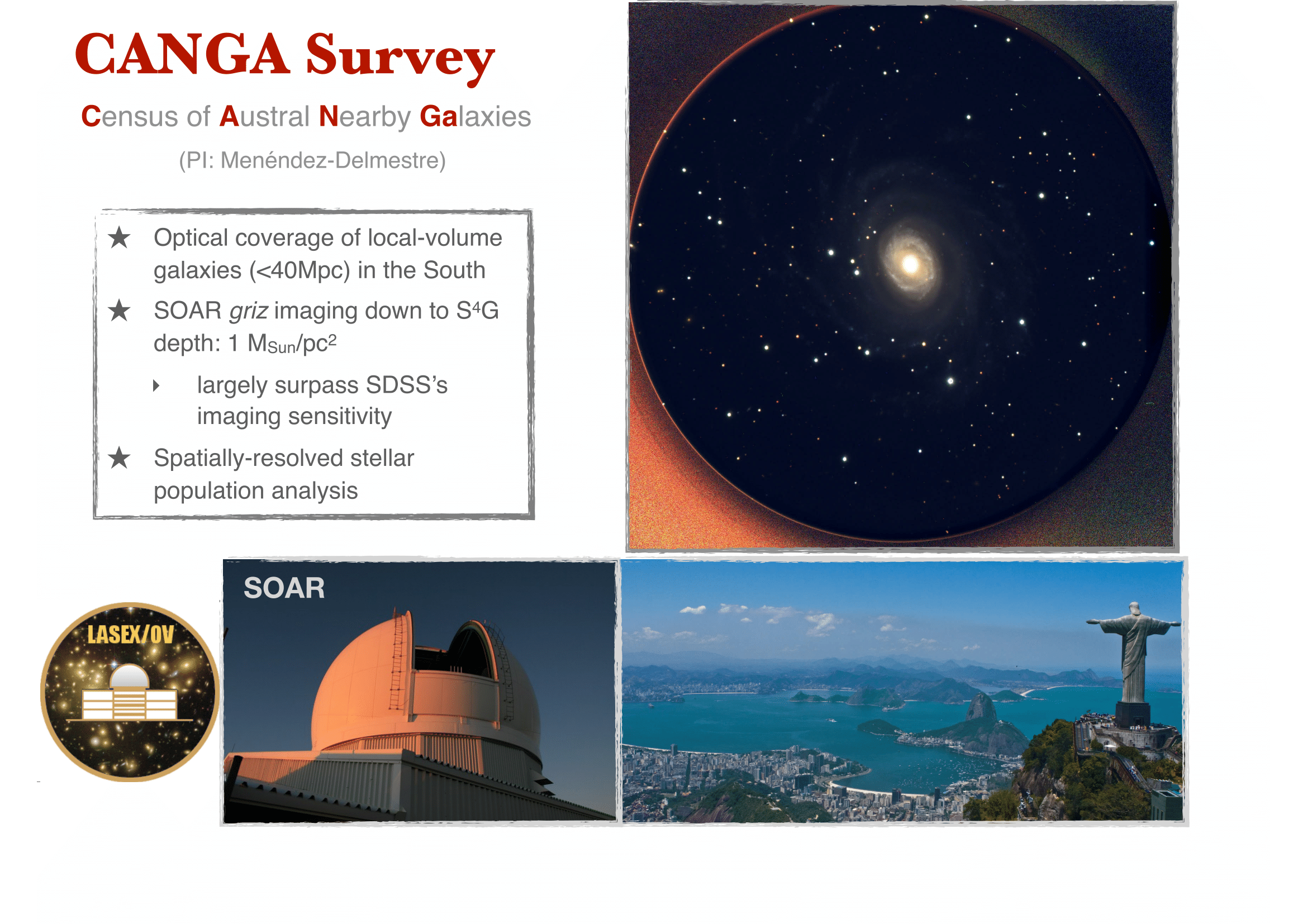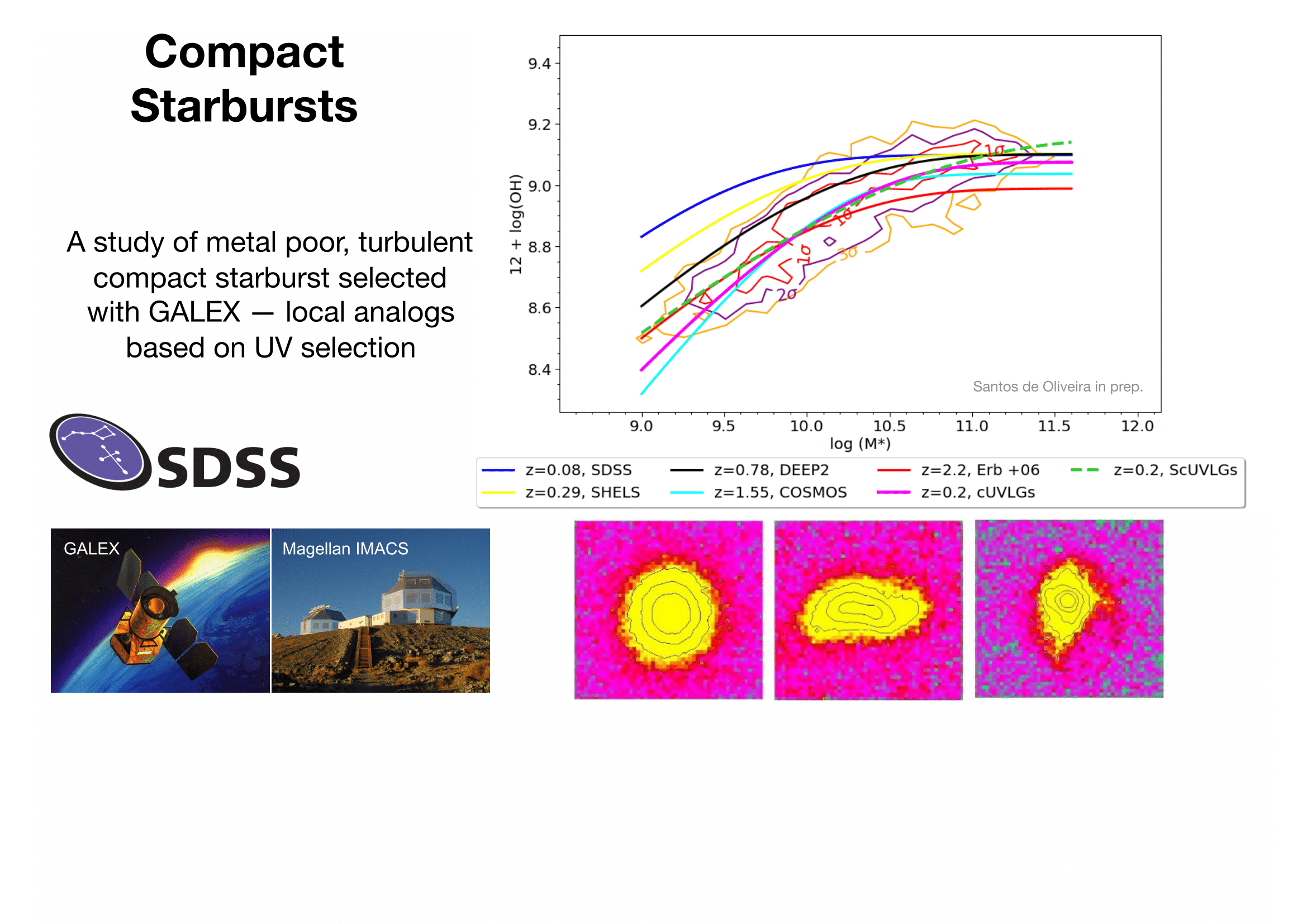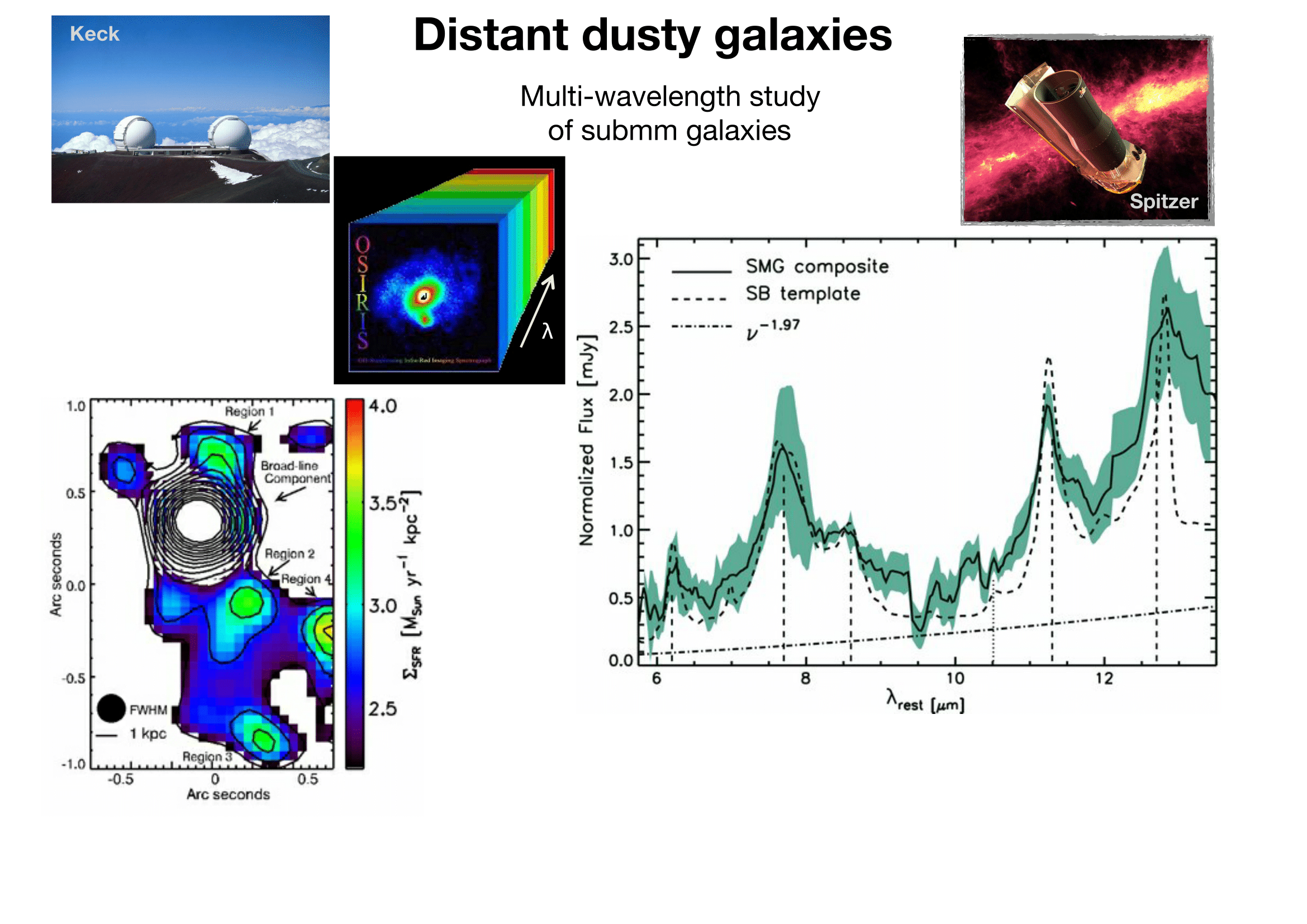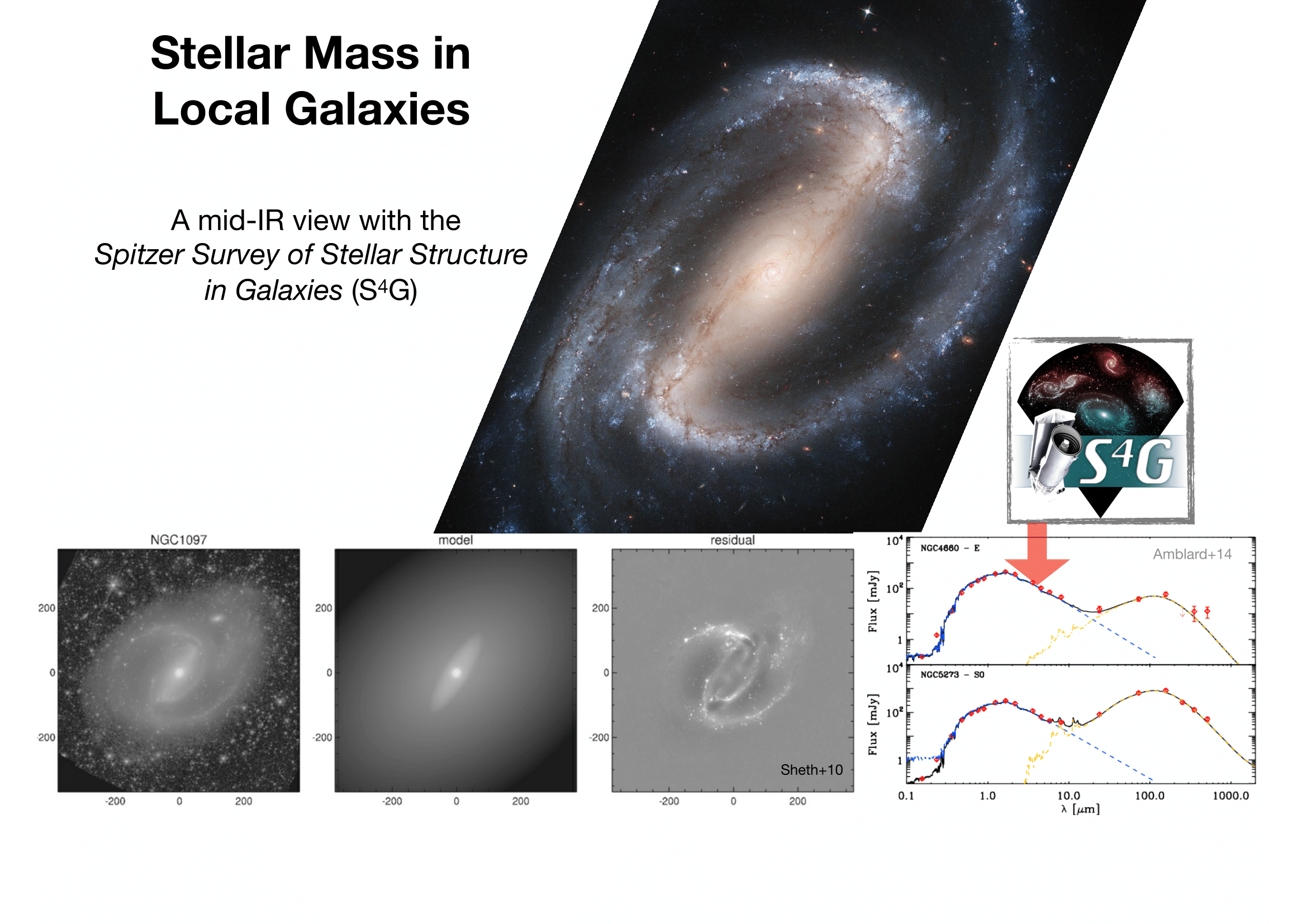Research
What keeps me busy at work…
My main research interests are in the realm of galaxy formation and galaxy evolution at high and low redshift using both ground-/space-based spectroscopic and imaging techniques.Some of my most recent research projects are the following:
It is over a decade since the discovery of a population of high-redshift galaxies (z~2-3) detected via their thermal dust emission redshifted into the mm/submm wavelengths. With high star-formation rates (SFRs∼100–1000M⊙/yr; Swinbank et al. 2004, Chapman et al. 2005) and large stellar masses (Mstellar~1011M⊙; Hainline et al. 2011), these dust-enshrouded submm galaxies (hereafter, SMGs) are favorite candidates to be the progenitors of today’s most massive elliptical galaxies.
[main collaborators: Lei Bai (U. Toronto), Thiago S. Gonçalves (Valongo, UFRJ, Brazil), Roderik Overzier (U. Texas at Austin), Antara Basu-Zych (NASA-Goddard), David R. Law (U. Toronto), Andy Monson (Carnegie), Eric Persson (Carnegie), Kevin Ludlum (Pomona College)].
The Galaxy Evolution Explorer (GALEX) has unveiled a population of low-redshift (z~0.1−0.3) intensely star-forming galaxies. These galaxies, luminous in the ultraviolet (UV-luminous galaxies, UVLGs;LFUV > 2×1010L⊙)comprisea diverse group: large, compact and super-compact UVLGs. Large UVLGs (I1530 < 108 L⊙/kpc2) are massive disk galaxies, similar to normal spirals in most respects, with large luminosities primarily due to their large sizes. The compact UVLGs (I1530: 108-9 L⊙/kpc2) are low-mass, relatively metal-poor systems that often have a disturbed/interacting morphologies; their high UV surface brightness and high specific star formation rate indicate that intense star formation is taking place. Super-compact UVLGs (I1530 > 109 L⊙/kpc2) are a subpopulation of compact UVLGs that share many properties with Lyman-break Galaxies at z~2-3 (Heckman et al. 2005), including luminosity, mass, star formation rate, specific star formation rate, extinction, and metallicity (Hoopes et al. 2007; Basu-Zych et al. 2007, 2009; Gonçalves et al. 2010): they are hence referred to as Lyman-break analogs (LBAs). We are in the process of completing an observational effort to study the optical and near-IR emission of a large sample of compact UVLGs and LBAs with a combination of instruments at the Las Campanas Observatory: the IMACS/IFU optical spectrograph and the FOURSTAR near-IR camera on the Baade 6.5m telescope and the near-IR cameras Retrocam and WIRC on the DuPont 2.5m telescope. With these data we are particularly interested in studying spatial metallicity gradients and stellar masses for these UVLG populations. Figure 4 shows an example of our IMACS/IFU observational component.
[main collaborators: Kartik Sheth (NRAO, Virginia), Cameron Charness (PhD student at U. Virginia), Kartik Sheth & the S4G team].
Bars are stellar structures in galaxies that play a central role in the evolution of their hosts. The non-axisymmetry of the bar induces large-scale streaming motions in the stars and the gas that lead to dramatic changes in the host galaxy. Hence, probing barred galaxies, determining the fraction of spiral galaxies that host a bar structure and studying the properties these bars are critical endeavours to understand the evolution of spiral galaxies in general. The redshift evolution of the bar fraction and that of bar properties is an important signpost on the growth and dynamic maturity of disk galaxies. In turn, the characterization of these parameters within the local universe plays an important role as an anchor for these high-redshfit studies. A few years back we undertook a comprehensive analysis of galactic structure in all bright, nearby spirals in the Two Micron All Sky Survey (2MASS), based on the identification of bars using the ellipse-fit approach shown in Figure 5 (Menéndez-Delmestre et al. 2007a). We established that the local near-IR bar fraction is 67±2%, consistent with previous optical and smaller infrared studies. Although the infrared is a better tracer of the stellar mass in galaxies (since the old stars dominate the luminosity at these wavebands), our work showed that high-redshift studies probing the rest-frame optical wavebands of galaxies are a viable approach to explore the evolution of the bar fraction. We have now started a similar investigation targetted to bar properties. In order to characterize the intrinsic bar evolution with redshift safe from band-shifting effects it is necessary to gauge how bar properties vary locally as a function of wavelength. Together with members of the S4G team (Spitzer Survey of Stellar Structure; PI: Kartik Sheth) we are studying a sample of barred galaxies in detail in the UV, optical and mid-IR to answer precisely this question.
[main collaborators: Peter Capak (Spitzer Science Center, SSC, Caltech), Claudia Scarlata (U. Minnesota), Kartik Sheth (NRAO), Harry Teplitz (SSC, Caltech), Manuel Aravena (ESO, Chile)].
Galaxy evolution is intimately connected to the environment and the galaxy position within the large-scale structure (LSS), but the physical origin of this galaxy-environment relation is still controversial. To understand the origin of the galaxy-environment relation, one needs to look back at the epoch of galaxy formation (z > 1), where initial conditions likely set the stage for the establishment of this relation. Galaxy clusters represent the most extreme density environments and are ideal laboratories to investigate the interplay between galaxy evolution and the environment. At higher redshifts, the local, high-density environments of well-established, virialized clusters give way to looser LSS. The strong clustering signature of SMGs indicates that these galaxies serve as excellent signposts of high-redshift LSS (see Blain et al. 2004, Chapman et al. 2009), making the immediate environments of SMGs excellent fields to study the galaxy-environment relation. We have initiated a major observational program to search for Ly-alpha emitters (LAEs) in the surroundings of SMGs through a combination of narrow-band imaging and multi-slit spectroscopic observations to: (1) probe for an excess in galaxy number density; (2) characterize the macro properties of the LSS or protocluster (e.g., shape, size, mass, virial state); and (3) follow up individual LAEs in multi-waveband databases to probe for trends in galaxy properties as a function of environment in the early stages of cluster virialization [in progress].




